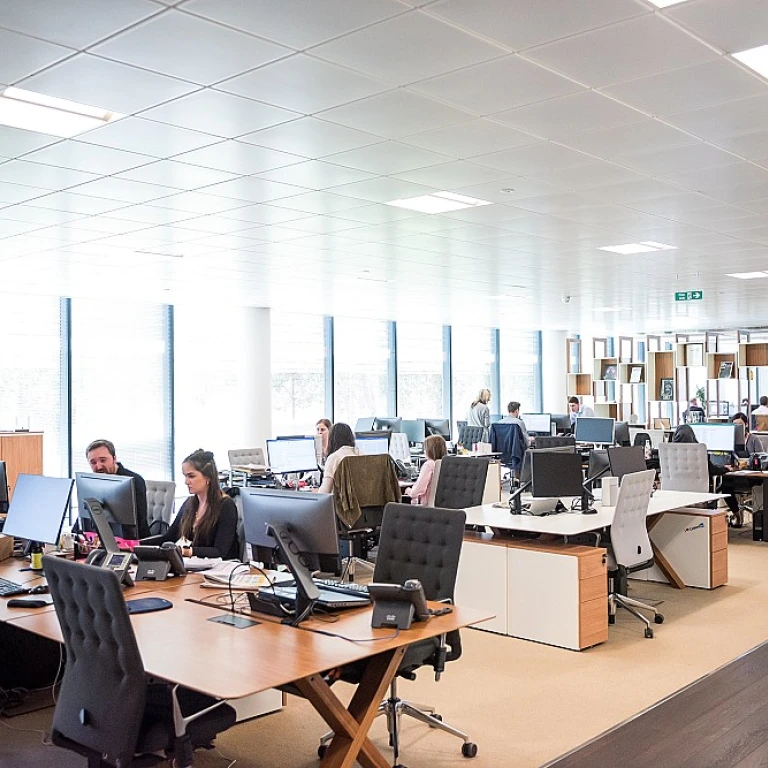
The Rise of Green Office Spaces in India: A Statistical Overview
Delving into the Eco-Friendly Transformation of Indian Workspaces
India's office landscape is rapidly evolving, with a notable shift towards green office spaces. A recent study indicated that the country has observed a 17% annual increase in the adoption of sustainable building practices. Further, the Indian Green Building Council (IGBC) aims to reach 10 billion sq. ft. of green building footprint by 2022, emphasizing the nation's commitment to eco-friendly work environments. This surge in green office spaces underlines the necessity for office managers to adopt comprehensive sustainability strategies as a core component of their management practices.
Optimizing Resources with Smart Paperless Solutions
The transition to paperless operations is a cornerstone for waste reduction in modern offices. A study reveals that the average office worker uses a staggering 10,000 sheets of copy paper each year, and approximately 45% of paper printed in offices ends up trashed by the end of the day. Developing digital workflows not only mitigates this waste but also enhances efficiency. Office managers can play a pivotal role by initiating cloud-based document management systems and encouraging digital correspondence, thereby reducing the office's carbon footprint and operational costs.
- Implementation of document management systems (DMS)
- Encouraging e-signatures and online forms
- Use of collaborative tools like Google Workspace or Microsoft Teams for reduced paper dependency
Revolutionizing Energy Consumption with Smart Technology
When it comes to power management, leveraging smart technology is the key to energy efficiency. Incorporating automated systems that control lighting, heating, and cooling can lead to significant energy savings. For instance, motion sensor lighting can reduce electricity usage by up to 30%, according to the Bureau of Energy Efficiency. Office managers should consider investing in sustainable technology such as LED lighting, programmable thermostats, and energy management software to monitor and optimize energy consumption.
"A stitch in time saves nine," says the old adage, and this certainly holds true when office managers proactively embrace energy-saving technologies, often resulting in decreased long-term operational expenses.
Promoting Green Citizenship in the Corporate World
Instituting a culture of environmental stewardship among the workforce is essential. Office managers can spearhead this change through regular sustainability training and by incentivizing green practices. Surveys show that when employees are engaged in corporate sustainability programs, they are more likely to adopt practices that contribute to the company's green goals. Activities such as volunteering for environmental causes, participating in carpool schemes, and adopting plants for the office not only promote a green culture but also boost team morale and productivity.
Assessing the Green Quotient: The Significance of Effective Metrics
Lastly, measuring the effectiveness of green initiatives is crucial. Metrics such as reduction in carbon emissions, water saved, and waste diverted from landfills provide tangible evidence of a company's social impact. These statistics not only showcase the company's dedication to sustainability but also resonate with eco-conscious clients and stakeholders. An impressive 73% of global consumers say they would change their consumption habits to reduce environmental impact, a Nielsen report states. Therefore, transparent reporting of these metrics can significantly enhance a company's brand image and contribute to its competitive edge in the market.
Implementing Waste Reduction Strategies: From Paperless Operations to Recycling Programs
A Green Revolution in India's Office Spaces
India is witnessing a significant shift in office management practices, with a strong emphasis on eco-friendly and sustainable solutions. The emergence of green office spaces is not just a trend, but a reflection of the growing environmental consciousness in the corporate sector. Recent statistics paint a promising picture: according to a study by the Indian Green Building Council (IGBC), green office buildings in India have increased by an impressive 20% over the last five years, signaling a robust transformation in the office landscape.
Understanding the Popularity of Sustainable Work Environments
These sustainable work environments are not just a badge of honor; they represent the forward-thinking approach of Indian businesses. A report from the Environmental Design + Construction Magazine indicates that companies operating within green buildings observe a drop in operating costs by an average of 25%, with energy savings up to 30-50% and water savings of 40%. These savings are a testament to the efficacy of the sustainable practices Indian office managers are keen to adopt.
- Increased Productivity: Employees working in green-certified buildings have been found to have a 15% increase in productivity, as per the World Green Building Council, making the case even stronger for progressively minded office managers.
- Attracting Top Talent: There's also a competitive edge in talent attraction, as a survey by the International Facility Management Association (IFMA) shows that 47% of employees are influenced by the sustainability of the workplace when choosing their employer.
Office managers are now becoming champions of change, with an eye on long-term economic benefits while contributing positively to the environment. Adopting green principles goes beyond the bottom line – it is about creating a workspace that promotes well-being, efficiency, and a healthier planet.
Energy Efficiency: Harnessing Technology for Sustainable Power Management
Stepping Towards Paperless Operations
With India's burgeoning emphasis on sustainable development, office managers have a pivotal role in driving their organizations towards eco-friendly practices. One significant strategy to consider is transitioning to paperless operations. Statistics reveal that reducing paper usage can have a profound impact—reports suggest that on average, an employee in a typical business office uses 10,000 sheets of copy paper each year. The implementation of digital documentation and data management systems not only contributes to conservation efforts but also enhances efficiency and accessibility of information. Implementing document management software and encouraging digital correspondence can vastly decrease an office's paper footprint.
Instituting Robust Recycling Programs
Where paper use is unavoidable, establishing an effective recycling program is vital. An office manager in India can take inspiration from global best practices where business recycling programs lead to an average waste reduction by 35%. A structured recycling initiative involves not only placing recycling bins in accessible areas but also educating employees on the types of materials that can be recycled and the proper way to do so. Partnering with certified waste management services ensures that the recyclable materials are processed responsibly, further affirming the office's commitment to environmental stewardship.
Adopting Green Procurement Policies
Going beyond waste reduction, eco-conscious office management also incorporates green procurement policies. By opting for supplies made from recycled materials or those with eco-friendly certifications, offices can significantly reduce their environmental impact. Currently, sustainable procurement practices in India are in a nascent stage, but the potential for growth is substantial with the increasing availability of green products in the market. Forward-thinking managers can leverage this trend to negotiate with vendors to supply products that contribute to a business's green objectives, setting an example and impacting the greater supply chain.
Engaging Employees in Sustainable Printing
Despite the push for digitalization, some scenarios still require printing. In such cases, office managers can encourage sustainable printing habits. This may include setting printers to default to double-sided printing, using recycled paper, or investing in printers with energy-saving features. Moreover, statistics from various eco-friendly campaigns show that simply informing staff about the environmental and financial costs associated with excessive printing can result in a decrease of paper usage by up to 20%. By creating an office culture that questions the necessity of each print job, managers can mitigate wastefulness and encourage mindful use of resources.
Reinventing Office Supplies with Environmental Considerations
Fostering an eco-friendly office space also extends to the reinvention of office supplies. From biodegradable pens to refillable cartridges, there's a growing market for sustainable office products that conscientious managers in India can tap into. Indicators suggest a positive trend towards these products, with sustainability-driven brands witnessing increased demands. Such initiatives not only minimize environmental impact but also often result in long-term cost savings, thereby making a compelling case for their integration into office management strategies.
Encouraging a Culture of Environmental Responsibility Among Employees
Maximizing Tech for Energy Conservation
Energy management stands as a pivotal aspect of sustainable office operations, with statistics indicating that electricity accounts for a significant portion of an office's operating costs and environmental footprint. A recent study showed that Indian businesses could save up to 30% on energy bills by adopting efficient technologies. Smart lighting systems that adjust based on occupancy and natural light levels, and energy-efficient appliances, underscore how technological integration can lead to substantial sustainability gains. Such solutions also well represent the seamless merger of cost-saving and eco-friendly practices in progressive office environments.
Optimizing HVAC Systems for Green Benefits
Heating, ventilation, and air conditioning (HVAC) systems are ubiquitous in modern offices and are often prime targets for energy optimization. A report by the Bureau of Energy Efficiency in India suggests that optimizing HVAC systems can lead to energy savings of up to 20-30%. For instance, implementing advanced climate control systems and regular maintenance checks can ensure that these systems run more efficiently, reducing energy consumption. Alternatively, installing programmable thermostats can empower office management teams to execute precise temperature control, aligning comfort with conservation.
Adopting Renewable Energy Sources for Long-Term Sustainability
The shift towards renewable energy sources such as solar and wind power is becoming increasingly viable. The Solar Energy Corporation of India notes a growing trend in solar power adoption, which not only mitigates an office's carbon footprint but also showcases a commitment to eco-friendly practices. Incorporating solar panels or wind turbines can transform an office into a beacon of sustainable innovation. This transformation not only aligns with the global sustainability goals but also resonates with the values of environmentally conscious customers and stakeholders.
Utilizing Energy Management Software
In a digitally-driven era, energy management software plays a crucial role in monitoring and optimizing energy usage. According to industry analysis, offices employing such software witness an average energy cost reduction of 10 to 20 percent. These tools allow for real-time tracking and provide actionable insights, enabling office managers to identify areas where energy is being wasted and implement immediate corrective measures. Data-driven decisions are the cornerstone of efficient energy management, turning office complexes into models of operational excellence.
Innovative Office Design that Promotes Energy Conservation
Ingenious office design goes beyond aesthetics—it's about embedding energy efficiency into the fabric of the workplace. For example, designing spaces with ample natural light can decrease the reliance on artificial lighting, thereby cutting down energy consumption significantly. Industry reports confirm the role of natural light in improving energy savings and boosting employee well-being, creating a winning situation for both the environment and the workforce. Integrating plants and green zones not only enhance air quality but also contribute to thermal regulation, further underscoring the multifaceted advantages of innovative design in office management.
Measuring Social Impact: Metrics for Assessing the Success of Green Initiatives
Instilling Eco-Consciousness in the Workplace Culture
Nurturing environmental stewardship within the employee base is a pivotal strategy in the quest for sustainability. Statistics reveal a growing trend: companies that engage their workforce in sustainability have a 78% higher chance of employee retention stat than those who don't. A company that demonstrates commitment to eco-friendly practices not only boosts its brand image but also fosters a deeper sense of purpose and satisfaction among its employees.
Promoting Green Practices Through Employee Engagement
Integral to this cultural shift is the adoption of workplace policies that promote sustainability. Incentive programs for reduced energy consumption or carpooling, and adopting digital tools to facilitate remote work stat and reduce office footprint are just sample pathways to enhancement. Regular training sessions can help employees stay abreast of the best sustainability stat practices and the benefits thereof, thereby promoting a green mindset.
- Introduce a "Sustainability Suggestion Box" to encourage innovative ideas.
- Organize 'Green Weeks' filled with workshops and eco-challenges.
- Recognize and reward green leaders and teams within the organization.
Leveraging Eco-Friendly Teams to Drive Change
Establishment of dedicated green teams within the office can amplify sustainability efforts. These teams, armed with personalized training on energy management stat and waste reduction, can lead by example, showcasing how small, everyday actions contribute to the company's broader environmental goals. Quoting an industrial leader, "Sustainability starts with accountability; green teams bridge that gap." Such teams often become the 'go-to' experts and motivators for their colleagues, further engraining eco-friendly habits into the fabric of the organization's culture.
Quantifying the Effect of Green Policies on Employee Morale
By implementing clear tracking methods, offices can highlight the link between sustainability initiatives and improved workplace atmosphere. According to recent findings, companies that have adopted comprehensive sustainability programs stat report a 23% increase in employee morale stat. Soliciting regular feedback through surveys can help identify which green measures are most impactful, ensuring that the initiatives resonate with employees and align with the overall sustainability goals set forth by the office management.



